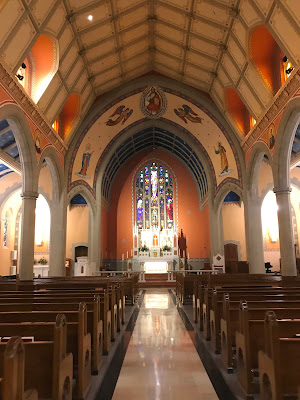This is Holy Family Parish in Latrobe, Pennsylvania.
The original look with its magnificent altar/reredos:
The first major renovation after Vatican II. One can only imagine how rank and file parishioners felt when their spectacular old altar/reredos was destroyed for this look, a puritanical/Presbyterian look. No wonder so many left the Church in this period which has had a trickle down effect to this day:
Then, there was an attempt to change things once again and it failed and miserably. I prefer the stark look above to this. At least in the first renovation the altar and tabernacle are substantial although ultra modern:
And the current restoration:




10 comments:
What a waste of time, money and heart ache only to get back to where they started.
The Church lost its collective mind during that era.
ByzRus,
You are spot on! Hubris of the highest order. Even so-called conservatives like Cardinal Cody of Chicago joined the forces of destruction!
Renovations were proposed by progressive liturgists/architects and all based upon obedience to the pope and what Vatican II had requested, or at least the spirit of Vatican II. In the 1960's and early 70's Catholics were still regimented to give uncritical and blind obedience to Church authorities. Prior to Vatican II, this obedience to authoritarian commands was normally about orthodoxy as it concerns Church teachings. After Vatican II, a pre-Vatican II authoritarianism was applied to heterodoxy not orthodoxy, novelty, not tradition. That is what is new, not the authoritarianism. Thus Catholics for the most part went along with proposed changes to their churches out of obedience and they paid for it with their money!
The amazing thing is that this Church maintained its altar railing throughout each wreckovation
In regard to wreckovations:
I recall that such changes as Mass versus populum, Communion in the hand, and the disappearance of Latin, had proved very popular throughout the Latin Church. But I recall that wreckovation projects were unpopular among folks in the pews.
The ruse among the wreckovators was that they had obeyed that which Vatican II had commanded.
Pax.
Mark Thomas
Mark
The old nazi line, but I was only following orders!
Many years ago one of our neighboring churches got a new pastor and he asked one Sunday" wonder what ever happened to the old altar tops and decorations I see in old pictures" He told me later that in confession a man told him, " Father I have all of it stored in my barn, Fr X ordered it all burned but i hid it and burned scrap wood, did I sin?" According to Fr he said "not if you bring it back". it's been restored and it is quite nice.
Well did he sin by disobeying the Priest?
Obedience might well have been the case at that time.
In other places, structures survived.
My grandmother's RC parish church burnt in 1963 after extensive renovations including new high and side altars, new marble rail with brass gates and mural art. Not an insignificant structure, the fire took several days in March of that year to put out. Post fire, mass was held in the school gym across the street. The walls and front of the church largely survived. At this time of change, a very close replica of the 1905 structure was built, the walls and front facade were reincorporated and in March of 1966, the church was dedicated on one day and the high and side altars were consecrated the following day. Even the 1905 bell was reused. Some of the smoke damage was left on the tower as a reminder of the tragedy.
The church remained unchanged, inclusive of no "people's altar" until close to 1980. The high altar was what I saw mass being celebrated upon while growing up. To this day, the high altar is used for First Friday Exposition and other liturgies as it has a table integrated into the top of the tabernacle. It is a much loved fixture that no one can imagine not being present. How they held out as long as they did belongs to history at this point. It was and remains a model of how things should have been. Unfortunately, the renovation in the very late '80s which resulted in an enlarged marble sanctuary saw the removal of the altar rail. Sad, but, the rest survived.
Mural art, not my favorite, was added about 15 years ago. They're gearing up for painting the church again and have engaged a liturgical arts company hopefully to repaint. Having toured the sacristy and having just attended there so often and for so many years, their appointments are not far removed from a cathedral.
In mid-1960s terms, the rebuilding cost slightly under $800K. Adjusted for inflation, it would have been an $8M rebuild.
Mark Thomas,
Those changes to the Mass were so “popular” that attendance at Sunday Mass plummeted , going from 80% of US Catholics before the changes to around 15% with the “new and improved!” Why do you persist in spreading these falsehoods? They are so easy to refute, so why bother? No one here believes you. So puerile.
Father McDonald,
I thought you would enjoy this news about 4 young men taking temporary vows at St John Cantius in Chicago, which is still flourishing! The bios are amazing!
https://www.canons-regular.org/post/profession-of-temporary-vows-august-14th-at-4-30pm
Here is how "popular" the Novus Ordo is in the following countries:
the lowest levels of weekly [Mass]attendance were observed in Lithuania (16%), Germany (14%), Canada (14%), Latvia (11%), Switzerland (11%), Brazil (8%), France (8%), and the Netherlands (7%).
By all means we should be listening to Germany!!!
Post a Comment